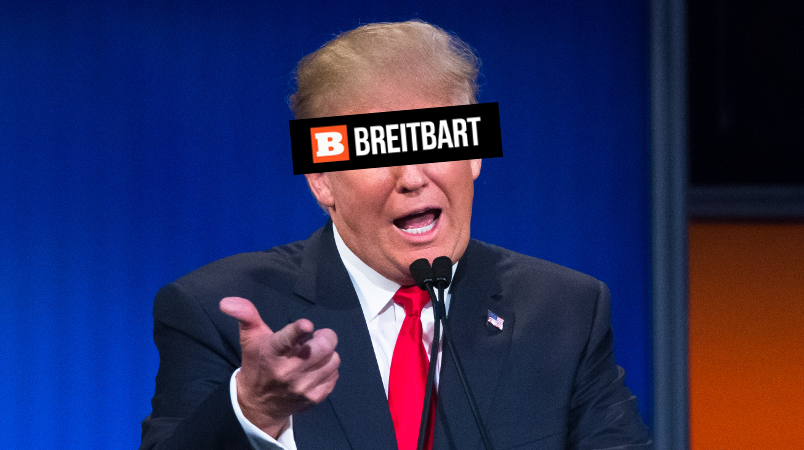Call it a match made in right-wing heaven.
Donald Trump’s hiring of Breitbart chairman Steve Bannon on Wednesday to be his campaign CEO marks the consummation of a months-long courtship with the conservative news and commentary site, which, under Bannon’s leadership, became Trump’s strongest media ally. Bannon will step down from his role at Breitbart to work with Trump, according to the campaign.
Trump sidelining Paul Manafort, who injected the campaign with a dose of seasoned professionalism, in favor of Bannon, once called the “most dangerous political operative in America,” also shows the real estate mogul firmly embracing the right-wing, establishment-hating fever swamps that fueled his candidacy since the beginning.
While the late Andrew Breitbart perhaps prophetically warned that Trump isn’t a conservative, his news site’s love affair with the New York real estate mogul started years before Trump was a candidate. The site feverishly covered Trump’s relentless self-promotion and zest for stirring up speculation he might run for office.
As far back as 2009, the site ran posts praising Trump for his handling of “Celebrity Apprentice” and lauding him as a hero for demanding President Barack Obama release his long form birth certificate. By 2013, writer Matthew Boyle had started landing Trump “exclusives,” including a preview of the CPAC speech the mogul delivered to a mostly empty room, and where he floated some of the same talking points that have become the bedrock of his 2016 campaign.
In June 2015, Ben Shapiro covered Trump’s campaign launch, declaring we had already hit “peak Trump.” Shapiro would later leave the site over its overt favoritism for Trump.
Speaking to the Huffington Post after the launch, Bannon said Trump’s message was already drawing on “the themes that have been on Breitbart.”
“It’s not that Trump’s late to the party,” Bannon told the site. “But he kind of came and picked up those themes.”
By the time Fox News hosted the first Republican primary debate in August, the site was firmly Team Trump in the largely one-sided feud that began after moderator Megyn Kelly grilled Trump over his derogatory remarks about women. While other conservative outlets found themselves between a rock and a hard place, Breitbart slammed Kelly for legitimizing “the ‘war on women’ mantra used by the Democratic Party” and condemned Fox’s debate as an “unfair” and “unbalanced attack” on Trump.
As BuzzFeed’s McKay Coppins has detailed, the unhinged attacks on Kelly suggested Breitbart’s editorial mission was bending to Trump’s will. Around this time, four anonymous Breitbart staffers said they believed Trump was paying to have favorable coverage of his candidacy blared across the site. Coppins also reported that Trump frequently called Bannon to personally pitch stories about himself. At the time, Bannon denied there was any pay-for-play arrangement in place with Trump, calling the anonymous staffers’ claims “a lie.”
The site’s affection for Trump again was thrown into stark relief when choosing sides in a dispute between one of its own and the campaign. After reporter Michelle Fields, who was on the trail covering Trump for Breitbart, accused then-campaign manager Corey Lewandowski of manhandling her after a Florida press conference, Breitbart News CEO and President Larry Solov released a statement hedging his bets. While Solov said “it’s obviously unacceptable that someone crossed a line” with Fields, he left the door open for other interpretations of what happened.
Notably absent from Breitbart’s response was a strong show of support for Fields, even as journalists and political operatives from both sides of the aisle praised her for speaking up. Although Fields published her account of the physical run-in on Breitbart, other staffers for the outlet continued to publicly question her account.
Editor Joel Pollak wrote a painstaking shot-by-shot breakdown of surveillance footage that he said exonerated Trump’s top aide. Writer Patrick Howley was briefly suspended for borrowing a line of attack from Lewandowski to smear Fields as an attention seeker, then went on to write a mocking post about Fields’ personal life.
Fields and Shapiro resigned over Breitbart’s handling of the incident, with Fields saying the organization had not “adequately stood by me.” Shapiro was more blunt, calling Bannon a “bully” who had sold out Andrew Breitbart’s mission to jump in bed with Trump, and slamming the site as “Trump’s personal Pravda.”
With its Trump flag flying high, the site has covered his every utterance—along with any story that could be construed as good news for the GOP nominee—with aplomb ever since. One fairly representative story, from earlier this month, attempted to pass off a photo of thousands of Cleveland residents packing the streets for the Cavaliers’ NBA championship celebration as an image of a Trump rally. In May, the site called Weekly Standard editor Bill Kristol, a fervent opponent of Trump, a “Republican spoiler” and “renegade Jew.”
Although the site launched a presidential poll as a rebuke to mainstream outlets, Breitbart’s Sunday numbers still found Hillary Clinton leading Trump by five points.
Breitbart trumpeted the news of Bannon’s ascendance on its front page Wednesday morning but didn’t manage to land that exclusive news from their own chairman. Instead, it relied on aggregating almost full stories from their avowed mainstream media enemies to cover the news.
This post has been updated.







How much longer until this buffoon hires James O’Keefe and Jesse Walters?
You know, the best Republican minds.
Breitbart is “Trump’s personal Pravda”?
I thought Pravda was Trump’s personal Pravda.
Because the “Weekly World News”, the “National Enquirer”, “The Star” and “The Globe” all have too much integrity and journalistic ethics.
What could possibly go wrong? Instead of “lock her up” it will be lynch her!
David Duke is next?